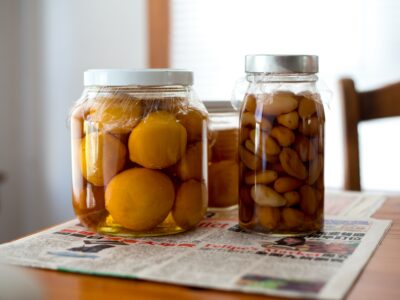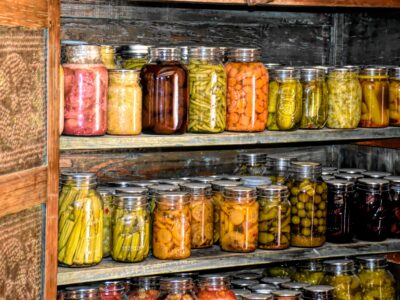Canning food is a time-honored practice that allows us to capture the freshness and flavors of the harvest season and enjoy them throughout the year. This centuries-old method of food preservation offers a way to extend the lifespan of fruits, vegetables, and even meats, ensuring that no produce goes to waste. In this comprehensive guide to canning food, we will explore the various techniques, equipment, and tips that will enable you to embark on your own canning journey. From selecting the right ingredients to mastering the art of proper sealing, let’s delve into the world of canning and unlock the joy of preserving nature’s bounty.
The Basics of Canning
Canning is the process of preserving food by placing it in airtight containers and subjecting it to heat, which kills bacteria, yeast, and molds that can cause spoilage. The two primary methods of canning are water bath canning and pressure canning. Water bath canning is suitable for high-acid foods like fruits, tomatoes, and pickles, while pressure canning is necessary for low-acid foods such as vegetables, meats, and soups. Understanding these methods and their respective requirements is essential for successful canning.
Equipment for Canning
To start your canning journey, you’ll need a few essential pieces of equipment. These include canning jars, lids, and bands, as well as a canning pot with a rack. Canning jars come in different sizes, but quart and pint-sized jars are the most commonly used. The lids and bands ensure a tight seal on the jars during the canning process. Additionally, you may need tools like a jar lifter, a canning funnel, and a headspace tool to aid in the canning process.
Selecting and Preparing Ingredients
Choosing fresh and high-quality ingredients is crucial for successful canning. Opt for fruits and vegetables at their peak ripeness to capture their optimal flavors. It’s important to wash and prepare the produce properly, removing any blemishes or damaged parts. Follow specific recipes for canning, ensuring that you use the appropriate ingredients and follow the recommended processing times and methods for each type of food.
Water Bath Canning
Water bath canning is a straightforward method that works well for high-acid foods. The process involves placing filled jars into a pot of boiling water and processing them for a specified time. The heat creates a vacuum seal, preventing the growth of harmful microorganisms. Water bath canning is ideal for fruits, jams, jellies, and pickles. It’s important to follow recipes and guidelines to ensure the correct processing time and safety measures are met.
Pressure Canning
Pressure canning is necessary for low-acid foods to prevent the risk of botulism. This method uses a specialized pressure canner to reach and maintain high temperatures, effectively killing any bacteria or spores. The high pressure inside the canner allows for safe processing of foods like vegetables, meats, and soups. It’s crucial to carefully follow instructions for pressure canning to ensure the correct pressure, processing time, and cooling methods are followed.
Safety Considerations
When canning food, it’s vital to prioritize safety to prevent foodborne illnesses. This includes using proper canning techniques, following reliable recipes from trusted sources, and maintaining hygiene throughout the process. Additionally, inspecting and storing canned goods properly is essential for long-term safety. It’s important to check for signs of spoilage before consuming canned food and to discard any cans that show bulging, leaking, or unusual odors.
Creative Canning Ideas
Canning provides an opportunity to get creative in the kitchen and explore various flavor combinations. Experiment with making your own fruit jams, chutneys, and salsas using seasonal produce. You can also create flavorful pickles by infusing different spices and herbs. Canning allows you to capture the essence of your garden or local farmers’ market and enjoy it year-round.
Enjoying Canned Foods
The joy of canning extends beyond the process itself. Opening a jar of homemade canned goods during the winter months brings the satisfaction of savoring the flavors of summer. Canned fruits can be used in pies, cobblers, or as toppings for desserts. Vegetables can be added to soups, stews, and casseroles. The possibilities are endless, and the taste of preserved goodness will remind you of the care and effort you put into capturing the harvest’s essence.
Canning food is a rewarding and practical skill that allows us to savor the flavors of the harvest season year-round. With the right techniques, equipment, and attention to safety, you can confidently embark on your canning journey. Embrace the tradition of preserving food, and relish the joy of opening a jar of homemade goodness in the midst of winter. Let canning become a part of your culinary repertoire and connect you to the abundance of nature’s bounty.
Like this article?
Check out my course on canning and fermenting!
An In-Depth Handbook into the Lost Art of Canning & Fermentation
The Magic of Canning In our workshop, you will learn the fundamentals of canning, from selecting the freshest produce to proper sterilization techniques. Fermentation, a traditional preservation technique that dates back centuries, is experiencing a revival in modern times due to its incredible health benefits and distinctive flavors. Connecting with Tradition and Nature Beyond the …




Hi, this is a comment.
To get started with moderating, editing, and deleting comments, please visit the Comments screen in the dashboard.
Commenter avatars come from Gravatar.